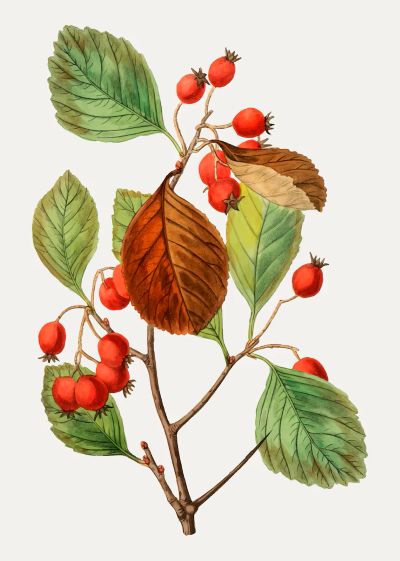Blood-red Hawthorn (Siberian Hawthorn)
- Description of Siberian Hawthorn
- Distribution and Ecology of Siberian Hawthorn
- Raw Materials from Siberian Hawthorn
- Chemical Composition of Siberian Hawthorn
- Uses and Benefits of Siberian Hawthorn
- Precautions for Using Siberian Hawthorn
- Contraindications for Using Siberian Hawthorn
- Medicinal Recipes with Siberian Hawthorn
- Cosmetic Uses of Siberian Hawthorn
- Culinary Uses of Siberian Hawthorn
Siberian Hawthorn
Crataegus sanguinea Pall.
Rosaceae Family
Description of Siberian Hawthorn
Siberian Hawthorn is a shrub or small tree, 3.3–13.1 ft (1–4 m) tall, with gray-brown bark and thorny branches (thorns 0.8–1.6 in or 2–4 cm). Leaves are alternate, rhombic or ovate, 1.2–2.4 in (3–6 cm), toothed, dark green, turning yellow-red in autumn. Flowers are white, 0.4–0.6 in (1–1.5 cm), gathered in corymbose inflorescences (2–4 in or 5–10 cm). Fruits are spherical or oval berries, 0.31–0.47 in (8–12 mm), bright red, with yellow flesh and 1–5 seeds. Cultivars: ‘Golden’, ‘Siberian’, ‘Red East’. Flowering occurs in May–June, fruiting in August–September.
Distribution and Ecology of Siberian Hawthorn
Siberian Hawthorn originates from Siberia, Central Asia, and Eastern Europe. It grows in the forest-steppe zones of Russia, Ukraine, Kazakhstan, and Mongolia, up to 4,921 ft (1,500 m) above sea level. Cultivated in gardens in Europe, Asia, and North America. Prefers loamy soils (pH 6.0–7.5), partial shade or sun, and irrigation of 4–5.3 gal (15–20 L) per bush every 10–14 days. Propagated by seeds, cuttings, or grafting. Yield: 22–44 lb (10–20 kg) per bush. Care includes pruning, potassium fertilization (0.53–0.71 oz/m² or 15–20 g/m²), and protection from aphids and spider mites. Used in landscaping, for hedges, and as a honey plant.
Raw Materials from Siberian Hawthorn
Raw materials include fruits (fructus Crataegi), flowers (flores Crataegi), and leaves (folia Crataegi). Fruits are harvested in August–September, dried at 104–122°F (40–50°C), yielding 15–20%. Flowers are collected in May–June, dried at 86–104°F (30–40°C), yielding 20–25%. Leaves are collected in June, dried at 104°F (40°C), yielding 20%. Quality standards: fruits red, mold-free; flowers white; leaves green; moisture <12%. Stored in airtight containers (fruits: 2 years; flowers: 1 year; leaves: 1 year). Aroma is faint, taste is bittersweet-sour.
Chemical Composition of Siberian Hawthorn
Fruits contain sugars (up to 11%), organic acids (malic, citric, up to 2%), pectins (up to 2%), vitamin C (up to 90 mg%), A, E, K, flavonoids (hyperoside, quercetin), tannins (up to 1%), minerals (K, Mg, Fe). Flowers contain flavonoids (up to 2%), essential oil, and chlorogenic acid. Leaves contain flavonoids, vitamin C (up to 120 mg%), and tannins. Fruit calories: 50–60 kcal/100 g.
Uses and Benefits of Siberian Hawthorn
Siberian Hawthorn has cardiotonic, hypotensive, sedative, antispasmodic, and antioxidant effects. It is used for heart failure, arrhythmias, hypertension, insomnia, neuroses, atherosclerosis, colds, and gastritis. Fruits strengthen the heart and improve circulation. Flowers lower blood pressure and calm the nervous system. Leaves aid in stress relief and throat inflammations. Infusions and decoctions normalize sleep and reduce cholesterol. Consult a healthcare professional before medicinal use.
Precautions for Using Siberian Hawthorn
Consuming >10.6 oz (300 g) of fruits or >3.4 oz (100 ml) of infusion daily may cause drowsiness or low blood pressure. Store juice at 32–41°F (0–5°C) for no longer than 24 hours. For children under 5, limit fruits to <0.71 oz (20 g) daily. Avoid unripe berries (may cause nausea). Wash fruits thoroughly to remove pesticides. Prolonged tincture use (>1 month) requires medical supervision.
Contraindications for Using Siberian Hawthorn
Siberian Hawthorn is contraindicated for allergies to Rosaceae, hypotension, bradycardia, pregnancy, lactation, and children under 2 years.
Medicinal Recipes with Siberian Hawthorn
- Flower infusion for hypertension. Steep 0.18 oz (5 g) flowers in 6.8 oz (200 ml) boiling water for 20 minutes, drink 1.7 oz (50 ml) twice daily for 10 days.
- Fruit decoction for arrhythmias. Boil 0.71 oz (20 g) dried fruits in 6.8 oz (200 ml) water for 15 minutes, drink 1.7 oz (50 ml) three times daily for 7 days.
- Fruit tincture for insomnia. Steep 0.71 oz (20 g) fruits in 3.4 oz (100 ml) 40% alcohol for 14 days, take 10 drops twice daily for 10 days.
- Leaf tea for stress. Steep 0.35 oz (10 g) leaves in 6.8 oz (200 ml) boiling water for 10 minutes, drink 3.4 oz (100 ml) twice daily for 5 days.
Cosmetic Uses of Siberian Hawthorn
Siberian Hawthorn is used for skin care.
- Rejuvenating mask. Mix 0.71 oz (20 g) fruit pulp with 0.34 oz (10 ml) honey, apply for 15 minutes, rinse, use twice weekly.
- Toning lotion. Mix 0.68 oz (20 ml) fruit juice with 0.34 oz (10 ml) water, wipe skin once daily.
- Leaf infusion for oily skin. Steep 0.35 oz (10 g) leaves in 3.4 oz (100 ml) boiling water for 20 minutes, wipe skin twice daily.
- Flower compress for inflammation. Steep 0.35 oz (10 g) flowers in 3.4 oz (100 ml) boiling water for 20 minutes, apply for 10 minutes twice daily.
Culinary Uses of Siberian Hawthorn
Fruits are used in beverages, jams, and fillings.
- Compote. Boil 7 oz (200 g) fruits with 34 oz (1 L) water and 1.76 oz (50 g) sugar for 10 minutes.
- Jam. Boil 2.2 lb (1 kg) fruits with 1.54 lb (700 g) sugar and 6.8 oz (200 ml) water for 35 minutes, store in jars.
- Fruit tea. Steep 0.35 oz (10 g) dried fruits in 6.8 oz (200 ml) boiling water for 5 minutes.
- Puree. Boil 17.6 oz (500 g) fruits for 20 minutes, puree, serve with honey.
Tips: Store fruits at 32–41°F (0–5°C) for up to 2 months, dried fruits up to 2 years. Remove seeds before preparation.
Other Uses of Siberian Hawthorn
Used in landscaping, as a honey plant, and for creating hedges.




